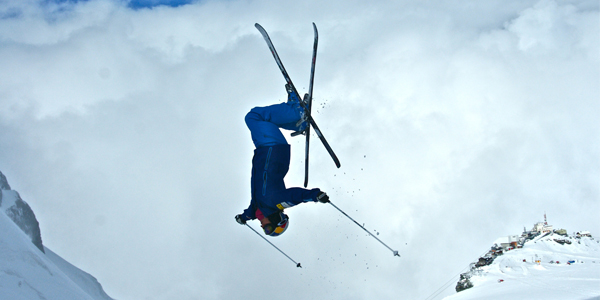Why Olympic Athletes Are Learning to Hold Their Breath for More Than Five Minutes

Olympic athletes are famous for doing just about anything to improve their performances. But can learning to hold your breath for more than five minutes and dive 100 feet under the ocean’s surface really help you on a snow-covered mountain?
A growing number of Olympians and Olympic hopefuls who play sports that have nothing to do with water think it can. And so, a collection of snowboarders and skiers-plus a motocross racer and two surf ironman champions-recently ventured off the shores of Kona, Hawaii, for a the sort of deep dive that is usually the domain of scuba experts, beach-rescue specialists and spear fishermen.
The goal is to learn how to control breathing and stay relaxed under uncomfortable, extreme circumstances, then adapt those lessons to moments of panic in more familiar surroundings-like staring down an icy mountain slope and facing a series of death-defying airborne flips and twists.
“I have to believe this can translate to the start gate, where it’s all about relaxing,” said Canadian Dara Howell, the 2014 Olympic champion in slopestyle skiing who forced herself 50 feet deep in the ocean last week. “That’s where this is going to help me.”
Olympic slopestyle skiing champion Dara Howell on a dive in the waters off Hawaii Red Bull
Even though Olympians risk life and limb for a living, that hardly means they are immune to nerves. When Howell starts her approach during competitions, she is “the most nervous person out there,” she said. To keep calm, she has relied on superstitious routines, such as always putting on the right ski before the left, grabbing the right pole before the left and then doing a fist pound with her coach. Sometimes that even worked, like in Sochi, but it was maddening to go through.
So when high-performance coaches with Howell’s sponsor, Red Bull, suggested there might be another way, Howell was all ears.
In recent years, Red Bull started working with longtime free diver Kirk Krack to develop a survival program for its big-wave surfers. Free divers like Krack specialize in taking a gulp of air and descending more than 500 feet below the surface of the water without carrying any oxygen. The idea wasn’t to get the surfers to win more competitions but to help them avoid drowning when waves crashed on top of them, trapping them under the water for a minute or more.
Krack, who is married to world-record free diver Mandy-Rae Cruickshank, said he can teach most people within a day how to hold their breath in a pool for nearly four minutes. The process starts with a warm-up period of slow breathing that lowers the heart rate. Divers then enter a kind of meditative state, fill their lungs with air, then close their throat in a way that relaxes the chest wall.
“The silver bullet in all breath holding is relaxation,” Krack said. “If I could flick a switch in your brain, I could have you do six minutes and 200 feet,” but he said the body’s first trigger when it stops breathing is to try desperately breathe. “Fear of falling, being eaten and suffocation are hard-wired and primal,” he said. “I’m trying to rewire that fight-or-flight instinct to not have to do with breathing.”
Dara Howell during the 2014 Winter Olympics in Sochi Agence Zoom/Getty Images
The more that Andy Walshe, Red Bull’s director of high performance, heard about Krack’s techniques, the more he thought they might help some athletes in the company’s stable, even those who never touched the water in its liquid form during competition.
“It’s a program that pushes you against your perceived limits in a very random way,” said Walshe, an Australian with a doctorate in applied biomechanics who has spent his career trying to convince athletes they are capable of far more than they realize.
It took one dive for Bobby Brown, an X Games gold medalist in freestyle skiing, to begin thinking about how he could use relaxation techniques to deal with the unexpected bump or mistake on a ski slope. For Howell and for Ben Ferguson, a rising star on the U.S. snowboard team, the ability to control their breathing meant a new understanding of how to deal with the inevitable jitters that come with trying new aerial tricks that involve multiple spins and flips above a hard, icy surface.
Before going to Kona, Ferguson, a 19-year-old Oregonian, figured he could hold his breath for 30 or 45 seconds, about what he used to do at his grandmother’s pool. On his first day training in a pool in Hawaii, he got to four minutes.
On his second day in the ocean, he descended down a rope 100 feet, using the pressure of air in his mouth to equalize the pressure building outside his ears, until his feet touched the sandy floor.
“I remember pulling myself down the vine and saying, ‘You are fine, just keep going, you are going to be all right,'” Ferguson said. “The idea for me is staying calm before I am dropping into the halfpipe. I know it will just translate.”
Heather McPhie, an American mogul skier who did Krack’s breath-holding camp in Kona last summer, ahead of the 2014 Olympics, described the experience as life-changing. McPhie, 30, grew up in Montana and didn’t swim in the ocean until she was 20. It terrified her; she couldn’t hold her breath for 20 seconds without panicking.
By the end of the camp, she was playing rock-paper-scissors 66 feet below the ocean’s surface.
“I can’t think of a time since that experience when I was scared,” said McPhie, who used to “freak out” standing at the top of an icy mogul course. “I don’t love ice now, but now I look at icy moguls and just go through them. You begin to notice that the fear of the danger does nothing to keep you safe.”
Source: Wall Street Journal

